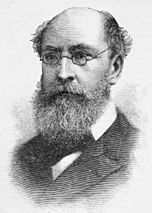Benjamin Apthorp Gould facts for kids
Quick facts for kids
Benjamin Apthorp Gould
|
|
|---|---|

Benjamin Apthorp Gould
|
|
| Born | September 27, 1824 Boston, Massachusetts
|
| Died | November 26, 1896 (aged 72) |
| Nationality | American |
| Alma mater | Harvard College |
| Known for | Astronomical Journal Gould Belt Gould designations |
| Spouse(s) | Mary Apthorp Quincy Gould |
| Awards | James Craig Watson Medal 1887 Gold Medal of the RAS 1883 |
| Scientific career | |
| Fields | Astronomy |
| Influences | Carl Friedrich Gauss |
| Signature | |
Benjamin Apthorp Gould (born September 27, 1824 – died November 26, 1896) was a very important American astronomer. He is famous for starting the Astronomical Journal. He also discovered the Gould Belt and helped create the Argentine National Observatory and the Argentine National Weather Service.
Contents
About Benjamin Apthorp Gould
Benjamin Apthorp Gould was born in Boston, Massachusetts. His father was the principal of Boston Latin School, where Benjamin also went to school.
After finishing at Harvard College in 1844, he traveled to Germany. There, he studied math and astronomy with a famous scientist named Carl Friedrich Gauss. During this time, he wrote about 20 papers on how comets and asteroids move. He was the first American to get a Ph.D. (a high-level degree) in astronomy.
After his studies, he visited many observatories in Europe. He asked astronomers for advice on how to make astronomy a more professional science in the United States. They told him to start a professional journal, like the leading astronomy magazine in the world at that time, the Astronomische Nachrichten.
Working with the U.S. Coast Survey
Gould returned to America in 1848. From 1852 to 1867, he worked for the United States Coast Survey. This group mapped the coastlines of the U.S. He was in charge of figuring out longitude (how far east or west a place is).
He found new ways to determine longitude using telegraphs. In 1866, he even used the Atlantic cable to find exact longitude differences between Europe and America. One of his helpers, Seth Carlo Chandler, later discovered the Chandler wobble, which is a small wobble in the Earth's rotation.
Starting the Astronomical Journal
In 1849, Gould started the Astronomical Journal. He published it until 1861, then started it again in 1885. This journal is still published today and is very important for astronomers.
From 1855 to 1859, he was the director of the Dudley Observatory in Albany, New York. He also worked on preparing records of astronomical observations from the U.S. Naval Observatory.
In 1851, Gould suggested a simple way to number asteroids in the order they were found. He also suggested using a circle symbol for them.
Astronomy in Argentina
In 1868, Benjamin Gould went to Argentina to help create a national observatory in Córdoba. In 1871, he became the first director of the Argentine National Observatory (now called Observatorio Astronómico de Córdoba).
While in Argentina, he and his team made detailed maps of the southern sky. They used new methods to measure the brightness of stars. He also helped create the Argentine National Weather Service, which was the first weather service in South America. This was important because astronomers needed good weather forecasts for their observations.
Gould was also a pioneer in using cameras for precise astronomy. In 1866, he measured photographs of the Pleiades star cluster. In Argentina, he took 1400 photos of southern star clusters. He spent his later years studying these photos.
He stayed in Argentina until 1885, then returned to Cambridge, Massachusetts.
Awards and Discoveries
Gould received important awards for his work. He got the Gold Medal of the Royal Astronomical Society in 1883 and the James Craig Watson Medal in 1887.
In 1877, he noticed a large group of stars in the Milky Way that seemed to form a belt. This feature is now called the Gould Belt in his honor. A crater on the Moon is also named after him.
Benjamin Apthorp Gould passed away in Cambridge, Massachusetts in 1896.
Mapping the Southern Sky
In 1874, Gould finished his most famous work, the Uranometria Argentina. This included an atlas (a book of maps) published in 1877 and a catalog (a list of stars) in 1879. For this work, he received the gold medal from the Royal Astronomical Society.
This atlas changed how constellation boundaries were drawn. It set them along lines of right ascension and declination (like lines of longitude and latitude for the sky). This system was later officially adopted for the entire sky in 1930.
The catalog also gave special Gould designations to bright stars in the southern sky. This was similar to what another astronomer, John Flamsteed, had done for the northern sky.
See also
 In Spanish: Benjamin Apthorp Gould para niños
In Spanish: Benjamin Apthorp Gould para niños
- Gould Belt
- Gould Belt Survey
Images for kids

